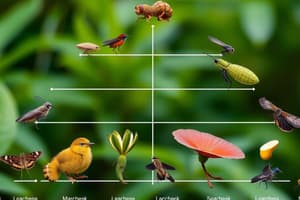Podcast
Questions and Answers
What is the primary characteristic of the Plant Kingdom?
What is the primary characteristic of the Plant Kingdom?
- One celled and no cell nucleus
- Absorb food from other living things or dead things
- Feed on living or once living
- Many celled and make their own food (correct)
What is the term for the grouping or organisms by characteristics and similar traits?
What is the term for the grouping or organisms by characteristics and similar traits?
- Reproduction
- Cell Structure
- Taxonomy
- Classification (correct)
What is the correct order of the Taxonomy Pyramid?
What is the correct order of the Taxonomy Pyramid?
- Species, Genus, Family, Order, Class, Phylum, Kingdom
- Kingdom, Class, Phylum, Order, Family, Genus, Species
- Kingdom, Phylum, Class, Order, Family, Genus, Species (correct)
- Phylum, Class, Kingdom, Order, Family, Genus, Species
What is the main characteristic of the Fungi Kingdom?
What is the main characteristic of the Fungi Kingdom?
What is the Science of naming, describing, and classifying organisms?
What is the Science of naming, describing, and classifying organisms?
What do most living things gain energy from?
What do most living things gain energy from?
What is the characteristic of the Monerans Kingdom?
What is the characteristic of the Monerans Kingdom?
What is the importance of plants in the ecosystem?
What is the importance of plants in the ecosystem?
What is the main function of the mitochondria in a cell?
What is the main function of the mitochondria in a cell?
What is the term for the smallest unit of life?
What is the term for the smallest unit of life?
Which type of cell has a membrane-covered nucleus?
Which type of cell has a membrane-covered nucleus?
What is the function of the lysosomes in a cell?
What is the function of the lysosomes in a cell?
What is the term for the outer layer of the cell that controls what enters and leaves the cell?
What is the term for the outer layer of the cell that controls what enters and leaves the cell?
What is the site where proteins are made in a cell?
What is the site where proteins are made in a cell?
What is the term for the jelly-like fluid that holds the organelles in a cell?
What is the term for the jelly-like fluid that holds the organelles in a cell?
What is the term for the process by which cells maintain a stable internal environment?
What is the term for the process by which cells maintain a stable internal environment?
Flashcards are hidden until you start studying
Study Notes
Classification of Organisms
- Carolus Linnaeus developed a classification system
- Scientists classify organisms based on:
- Cell structure
- Mode of nutrition
- Reproduction
Characteristics of Kingdoms
Animal Kingdom
- Multicellular
- Obtain food by consuming living or once living organisms
Plant Kingdom
- Multicellular
- Make their own food through photosynthesis
Fungi Kingdom
- Most are multicellular
- Obtain food by absorbing nutrients from other living or dead organisms
Protists Kingdom
- Most are single-celled
- Obtain food through photosynthesis, consuming living or once living organisms, or absorbing nutrients
Monerans Kingdom
- Single-celled
- No cell nucleus
- Some make their own food, while others obtain food by consuming living or once living organisms
Examples of Kingdoms
- Monerans: bacteria
- Protists: algae, amoebas, euglena, paramecium
- Fungi: mushrooms, yeasts, molds
- Plants: trees, flowers, grasses, ferns, mosses
- Animals: monkeys, humans, birds, frogs, fish, spiders
Importance of Plants
- Most living things gain energy directly or indirectly from plants
- Plants serve as a source of food and help maintain the Earth's climate
Cell Structure
- The smallest unit of life that can carry out activities
- All cells must:
- Obtain nutrients and energy
- Remove waste products
- Grow
- Reproduce
Cell Types
- Unicellular: made up of one cell
- Multicellular: made up of many cells
Cell Theory
- All living things are made up of cells
- Cells are the basic unit of life
- All cells come from existing cells
Cell Organization
- Cells → Tissues → Organs → Organ System
Organelles
- Structures within cells that enable them to live, grow, and reproduce
Cell Membrane
- Outer layer of the cell
- Allows nutrients in and waste out
- Protects the cell
- Controls incoming and outgoing substances
- Maintains concentrations of various substances
- Selectively permeable
Cytoplasm
- Jelly-like fluid within the cell
- Holds organelles
Nucleus
- Control center of the cell
- Contains the cell's DNA
Mitochondria
- Power center of the cell
- Provides energy for cellular activities
Ribosomes
- Site of protein synthesis
- Cell parts are made of proteins
Endoplasmic Reticulum
- Transportation system of the cell
- Rough ER: ribosomes attached
- Smooth ER: no ribosomes attached
Lysosomes
- Digest food, particles, and cell parts
- Protects the cell by digesting foreign invaders
Studying That Suits You
Use AI to generate personalized quizzes and flashcards to suit your learning preferences.




